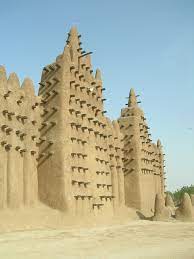Ancient to Medieval Mali and Niger: Djenné-Djenno sister city of Timbuktu

PD Lawton is a South African writer and researcher, committed…

image courtesy wikicommons : figure found at Djenné-Djenno still being held at the Metropolitan Museum of Art,New York.
Founded in the third century BCE, the city of Djenné-Djenno covered 33 hectares. It was abandoned around 1400 CE most likely due to drought inducing climate change. It is situated along the Niger River Valley in Mali and is thought to be the oldest urbanized site in West Africa.
As cited in The Cambridge World History, Vol 111, edited by Norman Yoffee:
“What the site does provide in ample volume is evidence of multiple occupations, multiple manufacturing areas and multiple “identity groups” as indicated by a great diversity of contemporaneous burial practices. “
What is so peculiar about Djenné-Djenno is a complete absence of a ruling class. There is no palace, no signs of upper class residences, no statues or monuments have ever been found within the vast city wall.
“…we have no hard evidence of a state-like, top-down, elite-driven political engine powering this kind of urbanism through time. We find no indications of kings, citadels, palaces, or, indeed, any obvious elites. The political and economic organization of the late first millennium BCE and later urbanism in the Middle Niger seems heterarchical . That is, one identifies separate, if sometimes overlapping, domains of authority, all functioning in an interactive field, not a vertical hierarchy of kings and subjects and unidirectional flows of information.” ( Ibid )
As in the case of Great Zimbabwe, the very well preserved Medieval city in Zimbabwe, academia has long denied the indigenous population the ancestral connection. It has long been claimed that sea-faring Phoenicians constructed Great Zimbabwe and not the indigenous people who once were the gold-trading Monomatopan Empire that stretched from Mozambique on the Indian Ocean to inland Zimbabwe and Zambia.

image: courtesy of wikicommons. figure found at Djenné-Djenno, still being held by De Young Museum, san Francisco
In the case of Djenné-Djenno it was long claimed that the Arab world civilized parts of Africa and spread peaceful Islam, never the reverse and that the culture of Niger and Mali could only have produced architecture as exquisite as the mosque of Djenne after the arrival of Arabs. It is since proven that this region was the breadbasket of the Sahel and the source of the civilized culture long before the arrival of Arab traders.
Subscribe now for updates from Msingi Afrika Magazine!
Receive notifications about new issues, products and offers.
What's Your Reaction?
 PIN IT
PIN ITPD Lawton is a South African writer and researcher, committed to the restoration of Africa to its rightful place in the world.



















